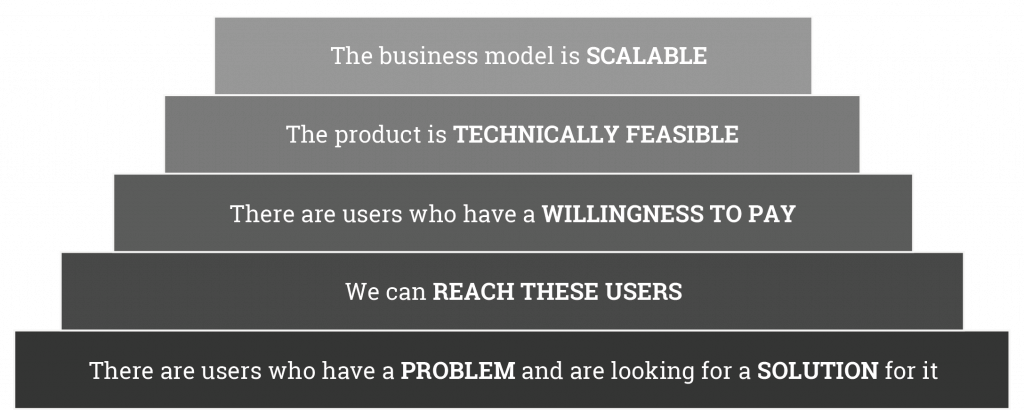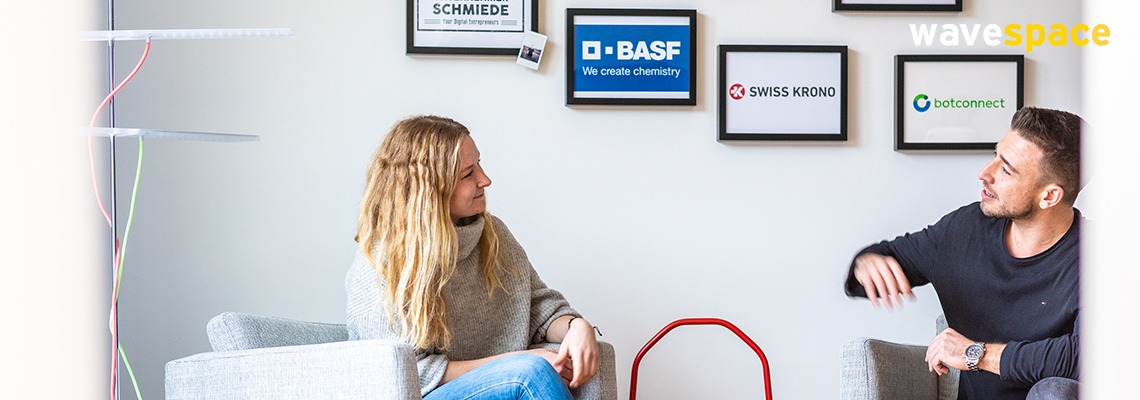A testing mindset – in search of a product market fit
26. June 2018
“There is a way to do better. Find him!” – Thomas Edison
At etventure we have tested many different approaches in numerous innovation projects. And it has been confirmed again and again: Success cannot be planned. You have to be aware of this at all times. In innovative product development, most of our decisions are based on assumptions. The aim is therefore to make the best possible use of the available resources in order to test these assumptions. The more skillfully you design such tests, the better the chances of product success. In the following I would like to outline our five most important findings.
Product market fit cannot be planned
72 percent of innovative software projects fail in first attempt – Chaos Report 2015
This realization is not surprising. Nevertheless, we have found time and again that many people intuitively assume that this phenomenon only applies to everyone else. That’s not true, of course. Even projects that were theoretically perfectly executed fail – at least from an economic point of view.
Therefore, the measurement criteria for success, especially in the development of innovative products, must be defined differently. In the end, it’s almost always about finding the product market fit. In other words, we try to develop a solution that harmonizes business objectives with customer needs. Finding this match is the ultimate challenge in innovative product development.
The success of an innovative project is therefore not primarily measured by software quality, sales or ROI, but by the knowledge gained. Finding out what doesn’t work is also valuable. Not every attempt automatically leads to financial success. Instead, many small tests have to be carried out to find the way to product market fit.
Reduce the cost of failure
The calculation is simple. The less effort, money and reputation it takes to test a particular assumption, the more attempts can be made to customize, extend, discard or completely rebuild the product.
At this point it is very important to recognise that it is not enough to find the best idea on your own. Social networking was not a unique idea (Myspace, studiVZ, etc.). The online dispatch was not a unique idea (WebVan, bücher.de, etc.). Making the Internet searchable was also not a unique idea (Altavista, Yahoo, etc.). All these ideas met a specific customer need and yet the companies were not sustainably successful.
Ultimately, what matters is implementation. And that doesn’t just mean the implementation of the software, but the entire process, in which an outstanding product is created step by step from many good and bad ideas. Under no circumstances, for example, could the Facebook project team have known beforehand exactly what would and would not work. Each new feature is a bet and requires an investment. And the less money you need to test an acceptance, the more such bets can be placed.
In this context, it has to be said once again that the much quoted startup maxim “Fail fast, Fail often” sets the wrong accent. The goal is not to lose as many bets as possible as quickly as possible. The aim is to reduce the cost of failure in order to increase the total number of bets. It’s about the “Fail cheap”.
Prioritize investments
Usually it is not easy to find the product market fit by randomly testing as many assumptions as possible. You also have to prioritize your investments well. Most hypotheses about a product idea fall into one of five categories. These should be checked in the correct order. If you skip one of these categories, you may miss the target completely.

Interest
Is anyone interested in the product idea? Are there already people trying to solve the problem? Would you test or recommend the solution?
Reachability of the target group
Do I reach my target group? This can be easily tested in the B2C area, e.g. by targeted displays or by issuing flyers. In the B2B area, the question of reach is sometimes more difficult to answer. Often legal, political or structural constraints must also be taken into account. In any case, the best product is worthless if you don’t have access to the target group.
Willingness to pay
This is not just about monetization. Much more important is whether users are generally willing to invest in the product. In the form of money, time, attention or reputation. A Facebook recommendation can also be used as an indicator of willingness to pay. In any case, one must be clear about the concrete user promise in order to create the right measurement criteria.
Technical feasibility
Only if the costs for manual processing are higher than the costs for the development of a digitized solution, it is worth investing money in software development. As long as you can handle things manually, it’s still easy to change course. Once you develop software, customizations become expensive.
Scalability
Only when there is a digital solution and the numbers to traffic, downloads or active users grow, it is worthwhile to think about scaling. There is no need to build an infrastructure that manages 100,000 users if you still wait in vain for the first 100. Yes, this means that you probably have to redevelop parts of the software. But to develop something new that you know will be used is much better than to develop something complex just to find out that you didn’t need it from the beginning.
Focus on outcome instead of output
Finally, one of the most important and at the same time most difficult to implement findings: absolute focus on outcome and not on output.
For explanation: The output describes a concrete work performance, while the outcome describes the results achieved in relation to the project goal. A painter who paints 10 paintings and sells them for 1 Euro each has a high output and a low outcome. A painter who paints a painting and sells it for 100 Euros has a comparatively low output, but a much higher outcome.
The release of the first software version is therefore no reason to celebrate. Only when the first customers have been won, the first payments received or the first assumptions confirmed, it’s time to celebrate. The software itself is worthless if it does not achieve the desired outcome.
And while we’re at it, I’d like to point out that the software is not the product. The combination of processes, customer approach, business model AND software is the product. Although Uber has a very practical application, it would not be nearly as successful if you had to wait 30 minutes for a driver.
The development of an innovative product is much more than just the execution of software specifics. The testing mindset helps to significantly increase the chances of success.





* Required field